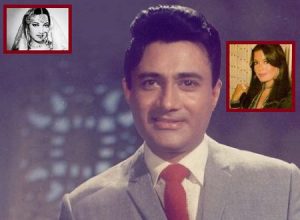
I am sure, like me many readers might be Dev Anand’s die-hard fans. Can Dev Anand be called the style icon? Yes certainly. In the 50s, 60s and 70s he brought in the fashion of scarves, mufflers and jackets and his signature puff which he imitated from his childhood idol Gregory Peck. He was a trendsetter and a guide, who gave an impetus to Bollywood fashion. On screen he personified serious and romantic roles with a penchant. His eyes spoke – he had the most expressive eyes that usually expressed more than words. Besides being a good looker Dev had the oodles of charm which left viewers spell bound!
He has the most memorable songs like Abhi na jao chodkar; koi son ke dlilwala, koi chandi ke dilwala, Jia o, Khoya khoya chand, aise to na dekho, tu kahan ye bata, arre yar mere tum bhi ho gazab, kahin bekhayal hoke, oh I can go on and on. Music was another facet of his films. He was lucky to have great singers rendering voice to him off screen and some of the great composers.
Some of the most popular Bollywood songs were filmed on him. Dev Anand’s association with music composers like – S. D. Burman and R. D. Burman, lyricists – Majrooh Sultanpuri, Neeraj, Shailendra and playback singer Mohammad Rafi and Kishore Kumar produced some of the best songs in the Bollywood history. Considering the fact that he was so full of life and bubbling with energy all the time, it doesn’t come as a surprise that the only film Dev Anand had a death scene in, was Guide. Dev Anand never went on funerals and never mourned anyone’s death. His philosophy about death was different.
Dev Anand had girls swooning over him. There was a time when female fans passionately started sending him letters in their blood especially after seeing him in a black suit. Such was his personality that he was warned or “banned” from wearing a black suit in public.
He preferred to look ahead, than looking back with nostalgia; in such a wonderful career that had milestones such as Baazi, Kala Pani, Kala Bazar, Paying Guest, Guide, Jewel Thief, Hum Dono , Teen Deviyan, Maya, Nau-Do-Gyarah etc; this because he had the tireless energy and the genius to craft more and more films.

It is said that in the 50s and 60s, the day his films were released, colleges and universities used to wear an abandoned look. His hurried style of dialogue delivery, his enchanting smile and the frequent nodding of head became his unmatched style, what is called ada in Urdu. He romanced yesteryear’s bold and beautiful actresses; most of them have vouched him being a gentleman.
Dev Anand was spotted by Ashok Kumar, who gave him a lead role in Ziddi, a production of Bombay Talkies. Before this, he had acted opposite the famous singer- actress Suraiya in the 40s, but Suraiya’s popularity surpassed his talent – leaving him high and dry. But, his off-screen failed romance with Suraiya filled many gossip columns.
It was during his period of struggle that he came across Guru Dutt, and the two made a promise to each other, whosoever achieved success first, would help the other. And, the rest is history. In 1951 Guru Dutt made Baazi, starring Dev Anand and Geeta Bali. The film became a trend-setter in urban crime thrillers and was a hit. The film also introduced Kalpana Kartik, who became Dev Anand’s lead heroine for many films like House No 44, Nau Do Gyarah and Taxi Driver (1954). After delivering some hits, Kalpana married Dev and retired from films.
He was a simple at heart. He never had stylish cars, never had a huge birthday bash and no show offs. Dev Anand took keen interest in politics. He formed a party called National Party of India which he later dispersed. He was among the group of film personalities who stood up to the internal emergency imposed by then Prime Minister of India, Indira Gandhi. In 1977, he actively campaigned against her with his supporters in the Lok Sabha.
He began his early career as he worked in the postal department of armed forces for a while. The actor was paid Rs 165 a month. His work was to read the letters that came for soldiers and censor any unwarranted information.
For Dev Anand, life in all shades was a festivity. Today, though he is not around, he still remains a dream hero with his peculiarity as well as eccentricity. His puffed hair style, a scarf around neck, drawl, the speech, the gait… all these made him what he was. Can brand Dev Anand ever be replaced? Certainly not.













































